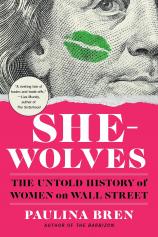She-Wolves: The Untold History of Women on Wall Street
Review
She-Wolves: The Untold History of Women on Wall Street
Outrageous fortunes are made through the buying and selling of stocks on Wall Street. The trading floors are active whether the prices for financial instruments are high (bullish) or are engaged in a sharp decline (bearish). Throughout much of its early existence, Wall Street was dominated by men. There were a variety of firms with their own exclusivity in terms of hiring practices, including Merrill Lynch, Morgan Stanley and Goldman Sachs. The one commonality amongst them was a non-existent female presence.
The key to gaining a foothold in a male-dominated culture was to be ambitious and make your mark. In the 19th century, Victoria Woodhull and Tennessee Claflin operated their own brokerage house. Nearly a century later, Mickie Siebert would purchase a seat on the New York Stock Exchange. Despite the inroads women had been making in society, most of Wall Street remained a boys’ club.
"SHE-WOLVES is a powerful work about inspiring women who paved the way for future titans of the finance industry."
The 1960s was a time of political and social upheaval. The Civil Rights and Women’s Rights movements went up against an ingrained culture on Wall Street that was hesitant to change. Women began to be admitted to esteemed institutions such as Harvard Business School. Yet they were often ignored by professors and set up to fail with various barriers placed in their way. Despite the obstructionist tactics, women like Lillian Lambert were resolute in meeting any challenge and receiving their degree.
Alice Jarcho’s breaking of the glass ceiling would result from a series of strange twists. She had gone from receptionist to office manager at a financial firm after the mental breakdown of her predecessor. However, she left the firm as they refused to pay for her Series 7 broker’s exam. Her next employer at Oppenheimer paid for the exam and would pave the way for her to trade on the floor of the NYSE.
As the ’60s gave way to the ’70s, the forces of feminism were beginning to make headway in challenging the stodginess of the masculine-favored establishment. Women were being hired at financial firms as arbitrageurs and featured on television programs such as “Wall Street Week.” A woman’s voice was being heard on multiple fronts, and she was providing financial guidance to uninitiated and experienced investors.
SHE-WOLVES charts the ascent of various women as they attempt to climb the formidable ladder of success in the financial markets. The battle would be fought over decades as women like Louise Jones and Marianne Spraggins ran up against harassment and discrimination in an environment dominated by male chauvinism. The fascinating paths of the ladies profiled would take them from storybook highs (seven-figure salaries) to devastating lows (market crashes). The markets were stagnant in the '70s but would be revived in the ’80s on the heels of deregulation and leveraged buyouts.
Paulina Bren, an award-winning historian and a professor at Vassar College, thoroughly highlights the unsung heroines and pioneers who started the liberation of the Wall Street patriarchy. SHE-WOLVES is a powerful work about inspiring women who paved the way for future titans of the finance industry.
Reviewed by Philip Zozzaro on October 12, 2024
She-Wolves: The Untold History of Women on Wall Street
- Publication Date: September 23, 2025
- Genres: History, Nonfiction
- Paperback: 400 pages
- Publisher: W. W. Norton & Company
- ISBN-10: 1324117656
- ISBN-13: 9781324117650




